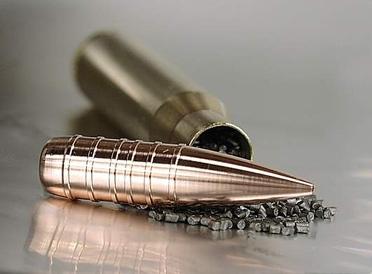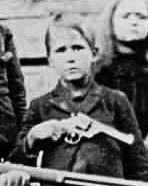

 The Accurate Reloading Forums
The Accurate Reloading Forums  THE ACCURATE RELOADING.COM FORUMS
THE ACCURATE RELOADING.COM FORUMS  Guns, Politics, Gunsmithing & Reloading
Guns, Politics, Gunsmithing & Reloading  Bullet Making
Bullet Making  Forgive my bullet making ignorance...
Forgive my bullet making ignorance...Go  | New  | Find  | Notify  | Tools  | Reply  |  |
one of us |
but how possible would it be to cast bullets made of brass? | ||
|
| One of Us |
Brass would have to be 2150 F to pour into a mold , best way to make brass bullets is in a collet lathe , If there is another way I'm sure someone here will inform us both of the better way . | |||
|
one of us |
Figures. I have a pretty good supply of scrap brass. | |||
|
| one of us |
I have swaged lead alloy bullets using air cooled wheel weights in my Corbin press and dies for handguns. I've found that there's not much to be gained over using pure lead. And it's work! In Corbin's literture he mentions using brass, bronze and copper to swage 'mono metal' bullets. However he's using a hydraulic press with one or one and one half inch dies. The equipment is a bit pricey. Jim "Whensoever the General Government assumes undelegated powers, its acts are unauthoritative, void, and of no force." --Thomas Jefferson | |||
|
| Moderator |
A practical way would be to make a mould and cast up a bunch of wax bullets and then use a lost wax technique to cast them. Only thing I don;'t know is how much shrinkage you'd have. for every hour in front of the computer you should have 3 hours outside | |||
|
| One of Us |
"Lost Wax" casting is used in jewelery. The form is carved in a hard wax and then the mold is formed around the wax using ceramic clay. The ceramic is fired, which removes the wax from the mold. Then the mold is poured. When it cools, the mold is broken open to retrieve the cast jewelery. This method is used for shapes that don't have "relief" and can't be released from a sand or metal mold. Seems like heaps of work for bullets, and not very practical. | |||
|
| new member |
Making solid brass or copper bullets from a piece of rod isn't too tough, depending on a couple of factors: 1. The diameter of the rod should be sized almost but not quite to final bullet diameter, maybe 0.001 to .0005 under. That gives just a tiny slip fit to the point form die cavity. 2. The rod should be cut to the right weight (which means length) with a small hole of 1/8 to 3/16 diameter drilled dead center down about half its axis. The hole is the secret to doing this without necessarily requiring a Corbin Hydro Press to do it. 3. The rod probably will require annealing unless you get it annealed condition, and if you try to form it in more than one stroke, you may have to anneal between attempts because it will tend to work harden very quickly. So one modernately quick stroke might do the job where two or three short attempts might not. 4. The ogive shape has a LOT to do with the required pressure. We've formed up nice .45 and .50 caliber solid brass bullets in a hand press (the large Mega Mite CSP-2 model) without undue effort, just a good firm two hand push, with a round nose shape. As you make the nose more pointed, toward the spitzer rifle shapes, more and more effort is required until eventually you just can't do it without hydraulic power. Proper lube is essential. Many lubes that are petroleum based will diesel or detonate at the pressures required here, which means they turn to ash in the die and you do not get any lubrication, but do get a stuck bullet. Corbin swage lube is a lanolin-based lube that doesn't diesel and it will work. STP may work, but it is pretty messy. Straight lanolin works but it is runny when hot and stiff when cold. | |||
|
| Powered by Social Strata |
| Please Wait. Your request is being processed... |
|
 The Accurate Reloading Forums
The Accurate Reloading Forums  THE ACCURATE RELOADING.COM FORUMS
THE ACCURATE RELOADING.COM FORUMS  Guns, Politics, Gunsmithing & Reloading
Guns, Politics, Gunsmithing & Reloading  Bullet Making
Bullet Making  Forgive my bullet making ignorance...
Forgive my bullet making ignorance...

Visit our on-line store for AR Memorabilia

